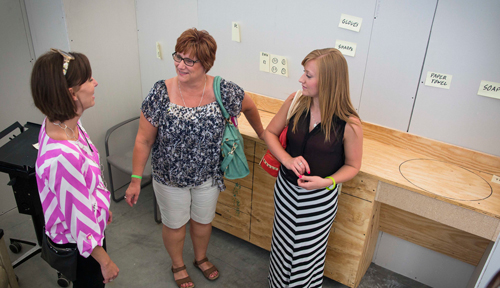Hope for the future.
That is how Patricia Gottschalk described the new Fred & Pamela Buffett Cancer Center. It is the reason she and daughter Shayla make the 10-hour round-trip commute from Hays, Kan., to participate in the Patient Family Advisory Council (PFAC) several times per year.
Last November, Gottschalk’s son, Shane, lost his battle with a rare form of non-Hodgkin’s lymphoma. He was 21.
Video: Patricia Gottschalk discusses the council.
“During Shane’s care, the doctors, nurses and techs did absolutely everything they could to save him. I just think the world of this place,” she said. “Contributing to the PFAC is part of our healing process.”
Organized and facilitated by Ann Yager, director of Village Pointe Cancer Center Radiation Oncology, the council is comprised of approximately 25 cancer patients, survivors and caregivers and serves as a sounding board for The Nebraska Medical Center’s oncology program. The diverse group shares one common thread — they know what it is like to be affected by cancer.
|
|
From a patient perspective, the team considers campus building projects and provides input on web pages, educational materials and other issues that impact the oncology patient population.
The council has played an integral role in guiding the design of the new Fred & Pamela Buffett Cancer Center.
“This is a very collaborative process. It really feels like we are contributing,” says Shayla, the youngest member of PFAC at age 19.
In an effort to provide PFAC and hospital staff members with an accurate sense of functional space, true-to-scale plywood mockups of clinical rooms were built. Guided tours allowed PFAC members and hospital staff to voice opinions on what works and what could use tweaking.
“Oh, we really got into it,” said breast cancer survivor and PFAC member Lisa Cudley. “There was one point where we were wheeling wheelchairs in and out of the patient shower space saying, ‘Is this really realistic? Will this comfortably fit a patient and their caregiver?'”
Designers are listening. Input from the PFAC is shaping key functions of the new cancer center.
“This exercise is challenging the way we think, the way we operate,” says Jen Bartholomew, manager of facilities planning for The Nebraska Medical Center. “If we considered only the needs of our providers and what would be most operationally efficient, we would be doing our patients a real disservice. With the PFAC’s involvement, we are putting the patient at the core of every decision.”
